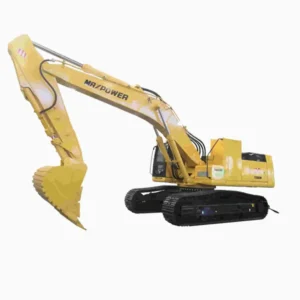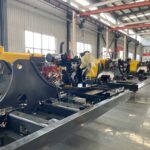Introduction
When it comes to construction and excavation projects, excavator bucket teeth play a crucial role in the digging and loading process. These small yet robust components are attached to the bucket of an excavator and are responsible for breaking through tough materials like rocks and compacted soil. Identifying the right type of bucket teeth for specific jobs is essential to ensure efficiency, productivity, and cost-effectiveness. In this article, we will explore the various aspects of excavator bucket teeth identification, helping you make informed decisions for your construction needs.
Understanding Excavator Bucket Teeth

Before delving into the identification process, it’s essential to understand what excavator bucket teeth are and how they function. These teeth are typically made from high-strength steel and come in various shapes and sizes, each designed for specific tasks. Their primary purpose is to penetrate the ground, scoop up materials, and withstand the forces involved in excavation work.
Types of Excavator Bucket Teeth
There are different types of excavator bucket teeth available in the market, each suitable for various soil and rock conditions. Some common types include:
Standard Bucket Teeth
Standard bucket teeth are the most commonly used type and are ideal for general excavation tasks. They have a straightforward design with a broad tip that works well in standard soil conditions.
Rock Chisel Bucket Teeth
For tougher and more abrasive terrains, rock chisel bucket teeth are the preferred choice. They have a pointed chisel-like tip that helps break through hard rocks and frozen ground.
Heavy-Duty Bucket Teeth
As the name suggests, heavy-duty bucket teeth are designed for extreme digging conditions, such as rocky or abrasive soils. They are reinforced with additional metal for enhanced durability.
Twin Tiger Bucket Teeth
Twin tiger bucket teeth are known for their excellent penetration capabilities and are used for digging in compacted soils. They have two pointed tips that aid in breaking and lifting.
Tapered Bucket Teeth
Tapered bucket teeth are versatile and work well in various conditions. They have a streamlined design that allows for easy penetration and reduced resistance during excavation.
Identifying Excavator Bucket Teeth
Identifying the right type of bucket teeth for your project requires careful consideration of several factors. Here’s a step-by-step guide to help you with the process:
Determine the Job Requirements
First and foremost, assess the nature of your excavation project. Consider factors like soil type, density, and the presence of rocks or other obstacles.
Consult the Excavator Manual
The excavator’s manual is a valuable resource that provides essential information about compatible bucket teeth types and specifications recommended by the manufacturer.
Measure the Bucket Teeth
Accurately measure the dimensions of your existing bucket teeth, if applicable. This will help you find replacements that fit perfectly.
Consider Tooth Adapter Options
Tooth adapters are components that connect the bucket teeth to the excavator bucket. Depending on your needs, you may require specific adapter types to ensure a secure fit.
Seek Expert Advice
If you’re unsure about the best bucket teeth for your project, consult with experts or suppliers who can guide you based on their experience and knowledge.
Maintenance and Replacement

Maintenance and replacement of excavator bucket teeth are critical aspects of ensuring the continued efficiency and performance of the excavation equipment. Proper care and timely replacements can extend the lifespan of the bucket teeth, reduce downtime, and ultimately save costs. Here are some essential points to consider when it comes to maintenance and replacement:
- Regular Inspections: Regularly inspecting the condition of the bucket teeth is essential. Visual checks can help identify signs of wear, damage, or deformities. Inspections should be carried out before and after each work shift to catch any issues early on.
- Cleaning: Keeping the bucket teeth clean is vital to prevent debris, dirt, and other materials from accumulating. Clean the teeth and the surrounding area after each use to avoid premature wear and damage.
- Sharpening and Reshaping: Depending on the type of excavation work and the terrain, bucket teeth may lose their sharpness over time. It’s crucial to monitor the teeth’s cutting edges and, when necessary, have them sharpened or reshaped by professionals to maintain optimal performance.
- Lubrication: Apply appropriate lubrication to the bucket teeth’s pivot points and moving parts regularly. This helps reduce friction, wear, and rust, ensuring smooth operation during excavation tasks.
- Replace Worn Teeth Promptly: As bucket teeth wear down, their digging efficiency decreases, leading to longer work hours and increased fuel consumption. It’s essential to have a replacement schedule in place and promptly change out worn teeth to maintain productivity.
Conclusion
In conclusion, identifying the right excavator bucket teeth is crucial for any construction or excavation project. The various types of bucket teeth available in the market offer versatility and specialization to meet the diverse needs of different soil conditions and digging tasks. By understanding the unique features and applications of each type, construction professionals can make informed decisions, optimizing productivity and efficiency while minimizing wear and tear on equipment.
Furthermore, regular maintenance of excavator bucket teeth is paramount to ensure their continued performance and longevity. Implementing a proactive maintenance schedule, including inspections, cleaning, and lubrication, will help detect and address potential issues early on, reducing the risk of unexpected breakdowns during critical project phases. Sharpening and reshaping the bucket teeth when needed will contribute to consistent digging efficiency and smoother excavation operations.
FAQs
Q1: How often should I replace excavator bucket teeth?
The frequency of replacement depends on factors like the intensity of use and the conditions of your excavation projects. Generally, it’s recommended to inspect the teeth regularly and replace them when they show signs of wear or damage.
Q2: Can I use the same bucket teeth for all types of soil?
While some bucket teeth are versatile and suitable for various conditions, it’s best to choose specialized teeth for specific soil types to ensure optimal efficiency and longevity.
Q3: Are excavator bucket teeth interchangeable between different excavator models?
In some cases, bucket teeth and adapters are compatible between certain models, but it’s crucial to verify compatibility with the manufacturer’s specifications.
Q4: How can I increase the lifespan of excavator bucket teeth?
Proper maintenance, including regular cleaning and inspection, will significantly extend the lifespan of your bucket teeth. Additionally, using the right type of teeth for specific tasks will reduce wear and tear.
Q5: Can I weld damaged bucket teeth?
Welding damaged bucket teeth is not recommended as it can weaken the tooth and compromise its performance. It’s best to replace the damaged teeth with new ones.






-150x150.webp)
